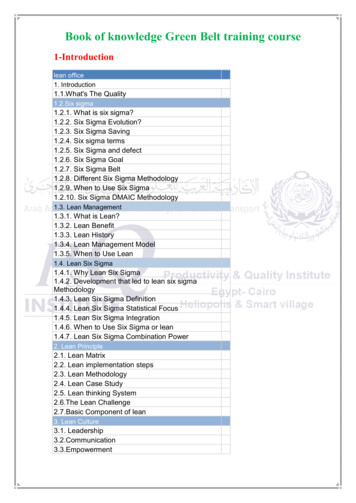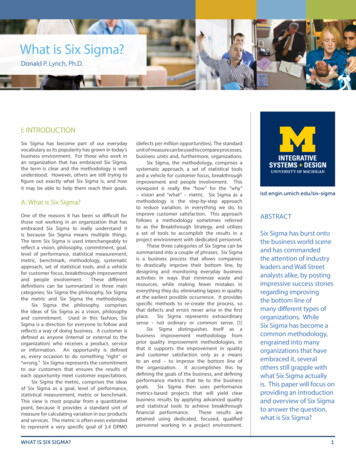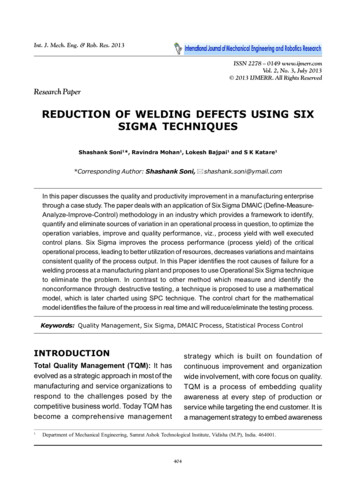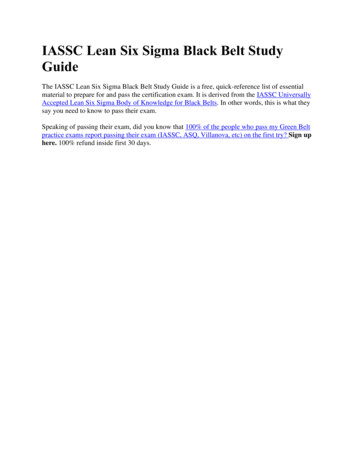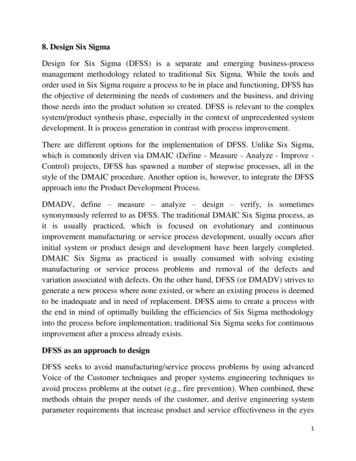
Transcription
International Journal of Industrial Engineering and Technology.ISSN 0974-3146 Volume 7, Number 1 (2015), pp. 15-30 International Research Publication Househttp://www.irphouse.comSix Sigma Methodology In A Plastic InjectionMolding Industry: A Case StudyAshish Mishra, Pankaj Mishra and SachendraKrishna Engineering College95, Loni Rd, Mohan NagarGhaziabad, U.P., IndiaAbstractThis study mainly focused on six sigma quality philosophy and other relatedphilosophy that is implemented in these studies in order to identify the Currentproblem or rejection criteria facing by a manufacturing company. The rootcause in this study for the black dot defect had been successfully determined.Corrective action to overcome this quality problem has been suggested. The“Six Sigma” Philosophy provides a step-by-step quality improvementMethodology that uses statistical methods to quantify variation.Introduction Most recent quality philosophy to be adopted by businessesaround the world is known as “Six Sigma.” The founder of the “Six Sigma”philosophy is Mikel Harry (Harry and Schroeder, 2000). Mikel Harrydeveloped and implemented his “Six Sigma” philosophy with the MotorolaCorporation and the philosophy has had great success at the GE Corporation(Harry and Schroeder, 2000). Six sigma focuses on the reduction and removalof variation by the application of an extensive set of statistical tools andsupporting software. This powerful business management strategy has beenexploited by many world class organizations such as General Electric (GE),Motorola, Honeywell, Toyota, ABB, Sony, to name a few from the long list.Six sigma applications in the service sector are still limited although it hasbeen embraced by many big service oriented companies such as J P Morgan,American Express, Lloyds TSB, Egg, City Bank, Zurich Financial Services,BT, etc.Six sigma today has evolved from merely a measurement of quality to anoverall business improvement strategy for a large number of companiesaround the world.The concept of six sigma was introduced by Bill Smith in 1986, a seniorengineer and scientist within Motorola’s communication Division, in responseto problems associated with high warranty claims. The success of the efforts
16Ashish Mishra, Pankaj Mishra and Sachendraat Motorola was not just achieving six sigma quality level rather the focus wason reducing defect rate in processes through the effective utilization ofpowerful and practical statistical tools and techniques. This would lead toimproved productivity, improved customer satisfaction, enhanced quality ofservice, reduced cost of operations or costs of poor quality, and so on.Literature ReviewNowadays, Six Sigma has been widely adopted in a variety of industries in the worldand it has become one of the most important subjects of debate in qualitymanagement. Six Sigma is a well-structured methodology that can help a companyachieve expected goal through continuous project improvement. Some challenges,however, have emerged with the execution of the Six Sigma. The development anovel approach to create critical Six Sigma projects and identify the priority of anyprojects. Firstly, the projects are created from two aspects, namely, organization’sbusiness strategic policies and voice of customer. Secondly, an analytic hierarchyprocess (AHP) model is implemented to evaluate the benefits of each project and; ahierarchical failure mode effects analysis (FMEA) is also developed to evaluate therisk of each project; and from which the priority of Six Sigma projects can bedetermined. Finally, based on the project benefits and risk, projects can be defined asGreen Belt, Black Belt, or others types of projects. An empirical case study ofsemiconductor foundry was utilized to explore the effectiveness of this approach [1].The cost benefit analysis is crucial, especially for companies whose products have asmall profit margin. Researchers are undergoing and two optimization models areproposed that will assist management to choose process improvement opportunities.These models consider a multi-stage, asynchronous manufacturing process with theopportunity to improve quality (scrap and rework rates) at each of the stages. The firstmodel is to maximizing the sigma quality level of a process under cost constraintwhile the selection of Six Sigma alternatives to maximize process returns isconsidered by the second model [2]. The strategic criteria are evaluated by themanagement team using a Delphi fuzzy multiple criteria decision-making method.Then, the tactical sub-criteria which contain additional operational issues areevaluated by the Six-Sigma Champion [3]. Implementation of the DMAIC (Define,Measurement, Analyze, Improve, and Control) based Six Sigma approach in order tooptimize the radial forging operation variables. In this research, the authors have kepttheir prime focus on minimizing the residual stress developed in componentsmanufactured by the radial forging process [4]. Despite the pervasiveness of SixSigma program implementations, there is increasing concern about implementationfailures. One reason many Six Sigma programs fail is because an implementationmodel on how to effectively guide the implementation of these programs is lacking.Using a successful Six Sigma program in a Network Technology company, thepurpose of this research is to develop an effective implementation model whichconsists of six steps. The first step is to perform strategic analysis driven by themarket and the customer. The second step is to establish a high- level, crossfunctional team to drive the improvement initiative. The third step is to identify
Six Sigma Methodology In A Plastic Injection Molding Industry17overall improvement tools. The fourth step is to perform high-level process mappingand to prioritize improvement opportunities. The fifth step is to develop a detailedplan for low-level improvement teams, and the sixth step is to implement, document,and revise as needed. Important for both practitioners and academicians, implicationsof our implementation experience along with directions for future research areprovided [5].Based on literature review, this research aims at1.To utilize six sigma methodology in performing the study.2.To study the “Black dot” rejects utilizing QC tools at the3.Identified production lines.4.To identify the root causes of the “Black dot” rejects.5.To recommend actions to improve the Black dot rejects and6.Sigma level.A Case StudyThe application of Six-Sigma methodology is a statistical analysis approach to qualitymanagement. In this approch the rejection ratio of 60-tone injection Mouldingproduction department in a company VIMAL PLASTICS, Noida was analyzedstatistically using DMAIC methodology and suggestions for quality improvement willbe made to the department.DMAIC – Define stageDefine the processBefore the process can be investigated, all circumstances have to be defined. Suchcircumstances are often described as SIPOC (Suppliers, Inputs, Process, Outputs andCustomers). The circumstances around the Moulding of Jar are listed in chronologicalorder below.Suppliers -Material supplier, RelianceInputs -Material, PMMA(Acrylic)Process -Receive PMMA and load into hopper-Dry PMMAFeed PMMA into Moulding machineMould JarDeliver JarOutputs -JarCustomers - external customers
18Ashish Mishra, Pankaj Mishra and SachendraIdentify the current reject problemThe in-line rejection based on the part produced.Table 1. In- line rejection based on part producedTOTAL 6.92ModelIn-line reject unit In-line (k-unit) Percentage Acc.RJ- J- 8013380.3384.8871.10FTC-100 20.2022.9280.81FTC-28 00Table 1 shows the rejection data for 60 tone injection Moulding for the monthof May 2009. This data shows the highest rejection ratio compared to the previousmonths rejection data ). Figure 1 shows the Pareto diagram for the particular partrejects based on the code name. The result shows that, part named ROUND JAR-3004have the highest rejection rate for the month which is 2284 units and contributes33.01 % of the total rejection rate. Since the part has the highest rejection rate it hasbeen taken as the studying element for the research.
Six Sigma Methodology In A Plastic Injection Molding IndustryK - UNIT19ACC - (%)1002.59080270601.55040130200.51000In – line rejectionFigure1: In- line rejection based on part producedDMAIC- Measure stageData was collected for 4 months continuously from June to September 2009(Appendix B) for output line reject that occurred in the 60 tone injection Mouldingpart production that focused on the production of part named Round Jar-3004 to trackdown the problem encountered by this particular part. Since there are four machinesproducing the same part, the reject data were collected for each machine. These datawere used to calculate defect per million opportunities (DPMO) for each month.Table 2 shows the total output, reject quantity, DPMO and sigma level for each monthfrom June to September 2009.Table 2: Total output and Sigma 9760149760599040Machine(reject quantity)E01 E03 E04 E06 TotalRej/mth DPMO SIGMA60935 910 40523103084.9 4.235653937 908 36722653024.8 4.242059946 878 39822813046.2 4.239723914 495 29117232301.1 4.3301195 3732 3191 14618579
20Ashish Mishra, Pankaj Mishra and SachendraSigma level from the above database for four months June 09 to Sept 09.Basic steps to Compute Sigma levelIdentify the CTQDefine defect opportunitiesCollect data on defectsCompute DPMOUse Standard formula to arrive at the Sigma levelFormula used to compute Sigma levelTotal pieces manufactured PTotal rejection RTotal CTQ ODefect per unit(DPU) R/PDPO DPU/CTQDPMO DPO 106Sigma level ( Z ) 0.8406 {29.37-2.221ln(DPMO)}Computed Sigma level for June 2009Total pieces manufactured, P 149760Total rejection,R 2310Total CTQ, O 5DPU,R/P 0.0154247DPO,DPU/CTQ 0.0030849DPMO,DPO 106 3084.9Sigma levelб 0.8406 {29.37-2.22ln(3084.9)} 4.2356A bar graph was constructed as in Figure 2, for each month based on RejectQuantity. Figure 2 shows that the highest rejection rate was identified in the monthJune 2009 meanwhile for other moths the data collected shows small variations.
Six Sigma Methodology In A Plastic Injection Molding Industry250021120240010023002200802100200060Total tMONTHFigure 2: In-line rejection from month June to September 2009Based on the data in table 2, the sigma level for the process were calculatedand illustrated as in figure 3. Calculation for the sigma level July to Sept 09 isattached in Appendix C. The figure 3 explains that the sigma level from the monthJune to September ranging from 4.2356 to 4.3301. This shows the average sigma levelfor the whole process is 4.262. The lowest sigma level was recorded for the monthJune and the highest sigma level was recorded on the month September. Since thesigma level for month June has the lowest sigma level, the studies or research will befocused on the month June. This data will used to track down the problem thatcontributes to highest reject on the part.
22Ashish Mishra, Pankaj Mishra and 7AugSeptMONTHFigure 3: Sigma level from month June to September 2009DMAIC- Analyze stageTable 3 shows the defect type’s data for the month June 2009 and Figure 4 illustratethe Pareto diagram for this particular data. As mentioned before, there are fourmachines which produce the same part which known as Round Jar-3004 and the datafor defects were collected based on machines. This is to identify the machine E03which contributes to the highest rejection rate. The defects which are recorded inTable 3 are the comment types of defects which normally occur on plastic parts whichproduced by using injection Moulding process. Figure 4 explains that black dotdefects are the major contributor for the rejection rate for the month June whichcontributes almost 40% of the total rejects compared to other defects. If defect datacompared by machine, still black dot contributes the highest defects compared toothers and for the machines, machine E03 contributes to highest black dot defectcompared to other machines. As a measure to track down the problem machine E03will be used to analyze the root cause for the black dot defects since it shows thehighest rejection rate and the analyze data will be used as references for othermachine.
Six Sigma Methodology In A Plastic Injection Molding Industry23Table 3:- Reject data based on the defect type for month June 2009Round Jar-3004DefectBlack DotScratchesDentedBurnmarkOily/DirtyShortMoldSink MarkPartingBurrWhitemarkSilverMarkOthersMachine NoE01 E03 E0438 347 2732304 2450160 16500117144350264102842186000002100No of Defects10009008007006005004003002001000E06 SubTotal Percentage 90150.6599.74330.1399.87020.0999.96010.04100Total 2310ACC (%)120100806040200Figure 4: Reject data based on the defect type for month June 2009
24Ashish Mishra, Pankaj Mishra and SachendraFigure5: Jars with black dot defectPotential causes for high defects occurred in part Round Jar-3004Analyzing the rejects based on models indicates that the highest percentage of defectsoccurred in model Round Jar-3004. Figure 6 shows the potential causes for highdefects. The number of defects is high when there are new models being introduced. Itmay be due to the operators not given enough training or no special training for theoperator to understand the correct method to produce the part. Besides that, the highdefects might contributed by the machines. The machines Might operate by newtechnicians that lack of training or experience. This will lead to misjudging in solvingthe problem during the machining process. Stressful environment also can lead tohigh rejects. It’s a human nature, where when workers find that the workingenvironment stressful, this will lead to dissatisfaction in working condition and at thesame time it also leads to high defects. Besides that the method or standard operationprinciples also can lead to high defects. Methods or SOP for the particular processmight be varying from the actual SOP for the process and this will contributes towrong machine setting or operation parameters.
Six Sigma Methodology In A Plastic Injection Molding Industry25High DefectLack of TrainingDo not understand the ProcedureNo special TrainingStressful Work environmentNew ModelMachine Operation and conditionPoor job satisfactionNew WorkFigure 6: Potential causes for high defectsRoot causes analysisIn order to determine the exact and most likely causes of major defects, aBrainstorming section was carried out with the Quality Engineer. Through thebrainstorming section, all possible causes including major and minor causes werelisted in the cause and effect diagram. The following section will discuss on the rootcauses for black dot defects.Root causes analysis for Black dot defectThe wrong part defect is caused by five major factors, which are machine,environment, man (operator), method and the material. Figure 7 shows the cause andeffect diagram for the black dot defect. Machines are one of the factors that must begiven black dot consideration. The machine contributes a lot of possibilities to blackdot rejection defect. Examples, without proper parameter setting it will result to acarbonized screw. Aging machines also can lead to defects. Maintenance also playsand important part because, without maintenance the performance of machine will beaffected and the desired output could not been gained. When an operator does nothave enough experience and practice, it is quite obvious that the operator producesmore defects than the others. Defects might occur when jobs carried out withoutguidance of leader or without any instruction. Besides that, number of defect willincrease when untrained operator or new operators are assigned to do the job.The work method is another major cause of the problem. It was found that theoperator did not know the correct method set the machine and the parameters but onlyfollowed the instructions without knowing the correct method. As a result the operator
26Ashish Mishra, Pankaj Mishra and Sachendracan lead to black dot defect or other rejection. Working environment was anothercause for the defect. It is based on company policy where, there are two shift with 12hours working period each in the production department. This can cause the operatorto loose concentration, become tired and bored doing the job. As a result theorganizations will hire new operator who do not have any knowledge or experience inthe production line. Besides that, a material as an important medium in injectionmolding process also contributes to some major defects. Examples, when material arecontaminated with other foreign particles it will effects the properties of the part andat the same time it lead to major defects.MANMETHODLack of skill ofcleaning screw& barrelNo proper die servicePP material not suitable forbarrelNo schedule for pp cleaningNo proper parting linecleaningBLACK DOTMaterial with dust &impuritiesBarrel was dirtyDust around the machine &uncomforted workingenvironmentMATERIALScrew wascarbonizedENVIRONMENTDie wasdirtyMACHINEFigure 7: Root causes analysis for black dotSummary on the analysisAs the conclusion for the analysis stage, the major defect found were black dot andseveral problems were identified as the main problems causes high defects in 60 toneinjection Moulding line. The main problem identified from the analyze section is themachine. This due to the data which colleted indicates that the major problem for eachmachine is the black dot. This shows that the major defect might cause by themachine. Although there are other factors affecting the reject problems, the mainconsideration has given to the machine factor. The next section will discuss aboutsuggestion for improvement.DMAIC- Improve stageAfter collecting and analyze the data, the identified defect was the black dot defectwhich caused major quality problem in the 60 tone injection Moulding line. Causeand effect diagram was also drawn to identify the causes of major defects. From heresuggestions recommended to reduce the defects was Screw and barrel cleaning.
Six Sigma Methodology In A Plastic Injection Molding Industry27Screw and barrel cleaningScrew cleaningThe injection screw was carbonized before cleaning, which was used to mould theRound jar-3004. After a request as a suggestion to the engineering group to clean thescrew. Sand paper and some chemical solvents were used to clean the screw. Most ofthe dirt was identified from the material which was carbonized because of overheatedin the barrel. The overheated material will stick on the screw and will released slowlyeach time injection and caused for the black dot on the surface of the Round jar-3004.Barrel cleaningIt was seen at the time of study the condition of machine which was not cleanedproperly where a lot of scrap material surround the tie bar and hydraulic unit area.This condition will lead to a situation where the foreign materials or scrap materialwill mixed original material and at the same time leads to black dot and other defects.After carry out the cleaning activity on the machine, the machine was coveredwith a plastic to make sure no dirt or dust affects the machine condition.Figure 8 shows a run chart that represent the Black Dot trend before and afterscrew cleaning process for machine E03. Based on the figure 8, the trend beforecleaning shows that the defects per day from 7th September to 23rd September ishigher than the trend after cleaning where the cleaning process perform on 24th ofSeptember. This clearly shows that the machine factor plays an important role and itneeds to maintain for time of period in order to eliminate or reduce the black dotproblem.The chart itself concludes that one of the main causes for the black dot is themachine condition. These results will be used by the production in charge member toperform continues action and at the same time improve the sigma level for theprocess.Table 4:- Total no. of rejection per day from 07 Sept 09 with Screw Barrel cleaningon 24 Sept 09Round Jar-3004Machine No 47683372436431
28Ashish Mishra, Pankaj Mishra and -Oct-0908-Oct-0934466912971927953Screw barrel cleaning324628213313264181246614
Six Sigma Methodology In A Plastic Injection Molding ct/0906/Oct/0907/Oct/0908/Oct/090DaysFigure 8: black dot trend before and after screw cleaning for machine E03From the analysis done for this project, a conclusion can be made that machinecondition is the major contributor for the black dot problem. Since the engineeringgroup member cannot clean the injection screw or the barrel every day, a newcleaning material agent was proposed or suggested to solve this problem.Summary on improve stageBased on the suggestion given, the rejection rate can be reduced and at the same timethe sigma level can be improve.DMAIC- Control stageControl stage is another important stage before completing DMAIC methodologies.This stage will describe the step taken to control. One of the comment types of qualitytool used is the control chart.Control charts is another popular statistical process control tools which is usedin this stage because it can detect abnormal variation in the process. In this operationwe can use c-chart because c-chart can monitors the number of defects per inspectionunit. Besides that c-chart also will monitor multiple types of quality in a product.
30Ashish Mishra, Pankaj Mishra and SachendraReferences1.2.3.4.5.6.7.8.Su,C.T, Chou.C.J.,” A systematic methodology for the creation of Six Sigmaprojects:A case study of semiconductor foundry”, Expert Systems withApplications, vol. 34, p.p.2693–2703, 2008.Kumar,D.U., Nowickib,D.,etal,” On the optimal selection of processalternatives in a Six Sigma implementation,” International JournalProduction Economics,vol. 111, p.p.456–467, 2008.Yang,T., Hsieh,C.H.,” Six-Sigma project selection using national qualityaward criteria and Delphi fuzzy multiple criteria decision-making method,”Expert Systems with Applications,vol. 36, p.p.7594–7603, 2009.Sahoo,A.K., Tiwari,M.K.,etal,” Six Sigma based approach to optimize radialforging operation variables,” journal of materials processing technology,vol.202, p.p.125–136, 2008.Chakravorty,S.S.,” Six Sigma programs: An implementation model,”International Journal Production Economics,vol. 119, p.p.1–16, 2009.Tennant, Geoff (2001). SIX SIGMA: SPC and TQM in Manufacturing andServices. Gower Publishing, Ltd. p. 6. ISBN 0-566-08374-4.Harry, Mikel J. (1988). The Nature of six sigma quality. Rolling Meadows,Illinois: Motorola University Press. p. 25. ISBN 978-1-56946-009-2.Keller, Paul A.; Keller, Paul (16 December 2010). Six Sigma Demystified.McGraw-Hill Professional. p. 40.
Six Sigma is a well-structured methodology that can help a company achieve expected goal through continuous project improvement. Some challenges, however, have emerged with the execution of the Six Sigma. The development a novel approach to create critical Six Sig
